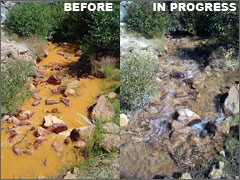Pacific Southwest, Region 9
Serving: Arizona, California, Hawaii, Nevada, Pacific Islands, 148 Tribes
Environmental Results through Tribal/EPA Partnerships
| '05 Accomplishments Home | Tribal Results | Clean Air | Safe Water | Protecting Tribal Lands | Healthy Tribal Communities | Compliance & Stewardship |
Protecting Tribal Lands 
EPA works collaboratively with tribes in one of the most diverse areas of the country, from the Monument Valley at Navajo Nation to the Yurok Reservation at the mouth of the Klamath River. EPA works on a government-to-government basis with the federally recognized tribes of the Pacific Southwest to protect more than 27 million acres, approximately 10% of the region's land base.

Both ordinary trash and hazardous waste threaten tribal lands. For example, tribal lands across the Pacific Southwest host over 800 open dumps, 175 abandoned or uncontrolled leaking underground storage tanks, and six Superfund caliber mine sites. In 2005, EPA was able to help many tribes close dumps, clean up metal waste, dispose of household hazardous waste, deal with abandoned vehicles and develop recycling programs.
Underground Storage Tanks
In 2005, EPA launched an initiative to assess and clean up abandoned leaking underground storage tank sites on tribal lands. Assessment and cleanup began at nine sites on the Hopi and San Carlos Reservations. The tribes are also gathering information on other sites to determine eligibility and priority for assessment and cleanup.
The final cleanup plan was implemented at the Tuba City underground storage tank site on the Hopi Reservation. All cleanup systems were installed, approximately 7,000 pounds of contamination were removed, and contaminant concentrations in the ground are decreasing.
At the Navajo Nation, thanks to increased inspections and enforcement, underground tank compliance rates jumped from 2% in 2002 to 54% in 2004.
Closing Open Dumps
The Hopland Band of Pomo Indians completed clean-ups at three open dump sites on their reservation. The project was funded by EPA and the California Integrated Waste Management Board, Farm and Ranch grant program.
With funding from EPA and the Bureau of Land Management, the Tohono O'odham Nation Solid Waste Management Program cleaned-up 84 sites which had accumulated approximately 40 tons of waste from undocumented migrants crossing the U.S.-Mexico border. The Pyramid Lake Paiute Tribe successfully closed all dumps on their reservation.

Cleaning up Superfund Sites
The Yerington Paiute Tribe, EPA, the State of Nevada, Bureau of Land Management, and other agencies investigated the 3,500 acre abandoned Anaconda copper mine. In December 2004, the Nevada Division of Environmental Protection asked EPA to take over the lead for this site. EPA issued an enforcement order to the responsible parties requiring short-term response actions. EPA conducted preliminary radiological screening using EPA's laboratory scanner van in the town of Yerington and on the Yerington and Walker River Paiute reservations. This included residential areas, where no anomalous radiation associated with the mine materials off site was found.
In 2005, EPA approved year-round acid treatment for the Leviathan Mine, now under development, with critical input from the Washoe Tribe. EPA worked closely with Washoe experts to begin the investigation of downstream resources - that impacted plants, animals, soil and water - affected by acid mine drainage. Several field events with Washoe participation helped to identify ecosystems and species for further investigation.
At the Rio Tinto Mine site, the responsible parties are completing their analysis of cleanup alternatives based on comments received from the Shoshone- Paiute Tribes of Duck Valley, EPA and the State of Nevada. EPA and the Tohono O'odham Nation made significant progress this year to reach agreement, in concept, on the Cypress Tohono Mine closure plan to be carried out by the Cypress Tohono Corporation.
Revitilizing Brownfields
EPA provided Brownfields funding for several projects on tribal lands. EPA's Tribal Response program assisted the Navajo Nation, Gila River Indian Community and Tohono O'odham Nation in establishing and enhancing their response programs, and developing an inventory of Brownfields sites. At the Salt River Pima-Maricopa Indian Community, the tribe used their Brownfields site assessment and cleanup grant to fully characterize and extinguish an underground fire at the 40-acre Old Tri-Cities Landfill. The tribe will complete the cleanup this year and evaluate development opportunities for the closed landfill.
The Wiyot Tribe, located at the Table Bluff Reservation, received a Brownfields grant to conduct environmental cleanup at Indian Island, a 6-acre shell mound on the island known as the historic location of the Tolowat Village of the Wiyot. Working with EPA, the U.S. Army Corps of Engineers, and California's North Coast Regional Water Quality Control Board, the tribe is moving forward on cultural and environmental restoration projects at the site. The cultural restoration involves the creation of a sacred tribal gathering place, a place to once again hold the World Renewal Ceremony. The Wiyot Tribe expects to begin cleanup in 2006.
Bead work created by Lori Seidner Clark
| Pacific Southwest NewsroomPacific Southwest Programs | Grants & FundingUS-Mexico Border | Media Center Careers | About EPA Region 9 (Pacific Southwest)A-Z Index |
